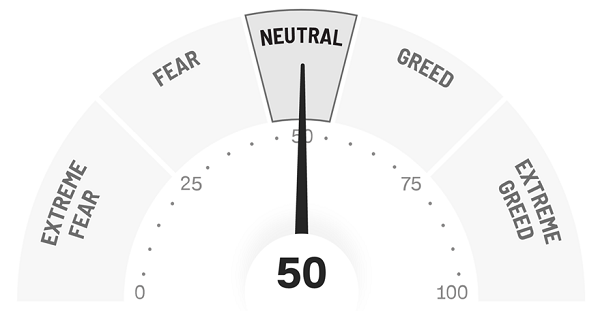At some point in my investing life, every participant turned into a trend follower. These “investors” like to buy when an established uptrend is already in place, when purchasing is perceived as “safe.”
Of course, this is the riskiest time to put new money to work. It is also the opposite of what we contrarian income investors do. We buy low and sell high. We do not, like the trend followers, buy high in hopes of selling even higher.
Buy and hope is not a strategy, as my favorite chardonnay label can attest:

(Shout out to my man Barry at Global View Capital Management for the work of art!)
Buying when everyone else is running for the hills is a plan that works repeatedly. But how do we know when the broader investing herd is down in the dumps?
Sentiment readings can help. We reference three studies often here at Contrarian Outlook. Let’s dive into them.
My “go to” emotion quantifier is CNN’s Fear & Greed Index. In recent years the FGI has been a helpful tool for me in identifying when a trend is likely to end. Last October, this indicator flashed a strong buy signal near the market’s washout lows. This came after a prescient caution flag two months earlier.
The FGI has seven components. I don’t love all seven, but in aggregate they have reflected fear and greed accurately in recent years.
FGI’s market momentum reading may be the least useful of the bunch. It simply rates whether the S&P 500 is trading above its 125-day moving average.
On the other hand its put/call ratio may be the best indicator for near-term bottoms. When the ratio of puts (bets that stocks will decline) to calls (bets that stocks will rise) is high, it’s a sign that there are few sellers left. The market is ready to rally.
Lately the FGI has been wafting around its Neutral reading. As contrarians, we prefer to do our heavy shopping when it is sitting in the Fear or, better yet, Extreme Fear zones.

SentimenTrader.com publishes another temperature reading that I like. Creator Jason Geopfert kindly allows me to share it with you here from time to time. The Smart Money/Dumb Money Confidence level measures the hubris of market participants.
The Dumb Money is named so for a reason: it’s made up of the investors who are always late to the party. They pile in at market tops and bail at bottoms, while their “Smart Money” counterparts (fundamental-focused managers) take their lunch money.
The “Dumb Money” usually aligns with CNN FGI’s bullishness, though it has diverged. Traditionally the Dumb Money reading (red line below) has reliably called bottoms in the market:
The Dumb Money: Most Scared at Market Lows

Source: SentimenTrader.com
The Dumb Money Confidence reading washed out at 0.28 last October. A great time to buy. In April, it only dipped to 0.47. (The FGI, meanwhile, had retreated to Fear territory.)
Finally the American Association of Individual Investors (AAII) publishes a weekly sentiment survey. AAII polls its members and asks if they are bullish, bearish or neutral on the stock market in the short term.
I don’t pay much attention to this widely quoted survey. Two sentiment tools (plus an informal scan of mainstream headlines) are plenty for me. Besides, the AAII numbers don’t move enough for my taste. AAII recorded 51.7% bulls on March 6 and only 32.1% bulls on April 24.
Not bad with the benefit of hindsight, but perhaps not the most actionable data for a real-time decision. After all, we don’t know in the moment whether sentiment readings will reverse the following week:
AAII Sentiment Survey YTD: Most Bullish and Bearish

AAII recorded 39% bulls last week, for what it’s worth.
These sentiment readings are most useful at extremes, especially bearish ones. Today, they are more or less in no man’s land which means, unfortunately, they are of limited value to us.
Once or twice a year, we do get a true wash out. Last October was a great buying opportunity with basement-level sentiment. April’s decline did not give us the same level of despair. Perhaps because most investors were waiting for such a signal, the market bounced without it.
The takeaway for a patient income investor? We will likely see a serious moment of despair later this year. Be ready for it, because moments like those tend to produce the best buying opportunities.
A benefit of being ready is that we will not be scared off. We aim to buy low, when these sentiment readings are in the pits. That is how we secure the most dividends for our dollar.
In doing so, we can “crisis-proof” our retirement portfolios. In this chaotic market, it is important to collect big dividends with a history of reliability. This is the cash flow that will get us through to the next big buying opportunity.
For a limited time, I’m giving away my number one secret for finding these big secure yields—click here and I’ll explain more.
